Dell XPS M1710 - GeForce Go 7900 GTX 512 Mobile Gaming, Part 1
by Jarred Walton on April 18, 2006 9:00 AM EST- Posted in
- Laptops
Features, Continued
The system that Dell shipped us is essentially maxed out -- the only upgrade you could still make would be to move to 4GB of RAM, but without a 64-bit Operating System you really wouldn't gain much (at least if you're planning on running Windows XP). Since Core Duo processors don't support 64-bit instructions, we'd recommend sticking with 2GB of RAM. Here's the configuration of the system we received for review, with a price of $4200.
To give you a better idea of the layout, we've included labeled images from various angles.
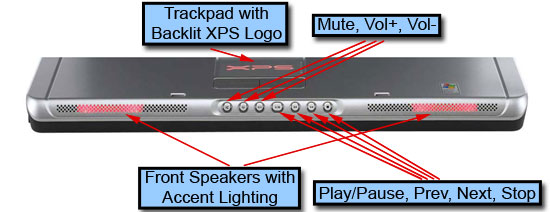
Starting with the front of the unit, you can see the buttons used to control volume and media playback. You can also see the lights behind the speaker grilles, glowing red in this image. The lights on the speakers as well as several other locations around the case can be set to one of 16 colors, or if you prefer you can also turn them off. A glowing XPS logo is also present on the trackpad, but it is limited to a red light. It too can be turned off.
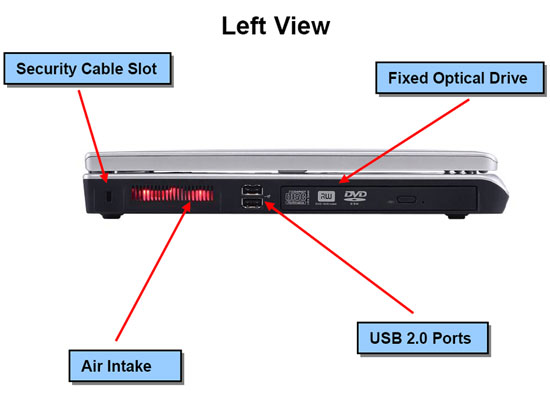
The left side of the unit houses the optical drive, along with two USB ports. The glowing air intake can once again be set to any of 16 colors.
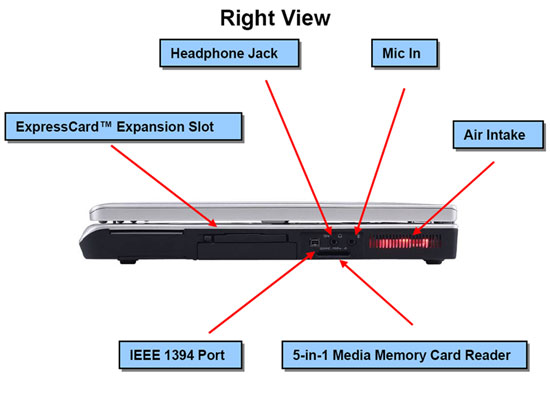
The right side has a 4-pin FireWire port, ExpressCard slot, 5-in-1 flash card reader, and the microphone/headphone audio jacks. Unfortunately, you cannot reconfigure the microphone port as anything but a line-in port, so you're stuck with either 2.1 audio or headphone support. Dell really should have included three audio ports in order to support 5.1 surround sound gaming; maybe next time. The air intake here matches the left side air intake, and both are set to the same color inside the BIOS.
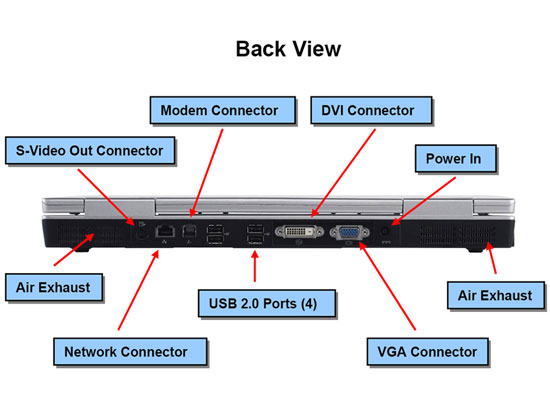
Finishing up with the rear of the unit, we have the majority of the connections. Note that both DVI and VGA display connections are present, which is good considering that most new LCDs use DVI ports. Also present on the rear is an S-VIDEO out port, Gigabit Ethernet, modem, and four more USB ports.
While the above images may help you understand where all of the ports and features are located, their size doesn't do a whole lot for conveying how the system actually looks. This is really a nice looking system, and at least in the notebook market Dell XPS systems are nothing to scoff at. We've included a few more higher resolution images of the system to give you a better idea of what it looks like. (Yes, the trackpad is located slightly left of center.)
The system that Dell shipped us is essentially maxed out -- the only upgrade you could still make would be to move to 4GB of RAM, but without a 64-bit Operating System you really wouldn't gain much (at least if you're planning on running Windows XP). Since Core Duo processors don't support 64-bit instructions, we'd recommend sticking with 2GB of RAM. Here's the configuration of the system we received for review, with a price of $4200.
| Dell XPS M1710 System As Tested | |
| Processor | Intel Core Duo T2600 (2.16 GHz 2x2MB) |
| Chipset | Intel 945PM 64-bit Dual-Channel |
| FSB Speeds | 667 MHz |
| Memory | 2 x 1024MB DDR2-667 SO-DIMM (5-5-5-15 timings) |
| Graphics | NVIDIA GeForce Go 7900 GTX 512MB GDDR3 |
| Display | 17" WUXGA (1920x1200) UltraSharp with TrueLife |
| Hard Drive | 100GB 7200RPM 8MB |
| Optical Drive | DVD+/-RW with Dual-Layer DVD+R Write Support |
| Networking | Integrated 10/100/1000 PCIe Gigabit Ethernet and 56K Modem Intel Pro/Wireless 3945 802.11a/b/g Mini Card Bluetooth Module |
To give you a better idea of the layout, we've included labeled images from various angles.

Starting with the front of the unit, you can see the buttons used to control volume and media playback. You can also see the lights behind the speaker grilles, glowing red in this image. The lights on the speakers as well as several other locations around the case can be set to one of 16 colors, or if you prefer you can also turn them off. A glowing XPS logo is also present on the trackpad, but it is limited to a red light. It too can be turned off.

The left side of the unit houses the optical drive, along with two USB ports. The glowing air intake can once again be set to any of 16 colors.

The right side has a 4-pin FireWire port, ExpressCard slot, 5-in-1 flash card reader, and the microphone/headphone audio jacks. Unfortunately, you cannot reconfigure the microphone port as anything but a line-in port, so you're stuck with either 2.1 audio or headphone support. Dell really should have included three audio ports in order to support 5.1 surround sound gaming; maybe next time. The air intake here matches the left side air intake, and both are set to the same color inside the BIOS.

Finishing up with the rear of the unit, we have the majority of the connections. Note that both DVI and VGA display connections are present, which is good considering that most new LCDs use DVI ports. Also present on the rear is an S-VIDEO out port, Gigabit Ethernet, modem, and four more USB ports.
While the above images may help you understand where all of the ports and features are located, their size doesn't do a whole lot for conveying how the system actually looks. This is really a nice looking system, and at least in the notebook market Dell XPS systems are nothing to scoff at. We've included a few more higher resolution images of the system to give you a better idea of what it looks like. (Yes, the trackpad is located slightly left of center.)
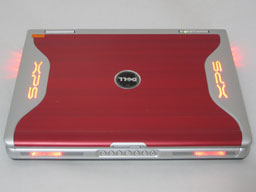 |
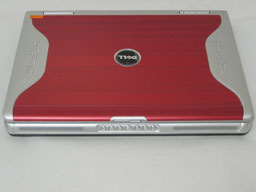 |
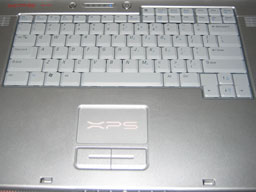 |
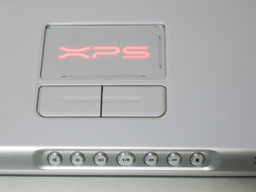 |
| Click to enlarge | |










69 Comments
View All Comments
JarredWalton - Thursday, April 20, 2006 - link
I received the following email, and thought the response would be useful for others:-----------
Thank you for the informative article on the Dell Gaming system. I was curious on if you know how this Laptop: http://www.sagernotebook.com/pages/go_np5950.html">http://www.sagernotebook.com/pages/go_np5950.html would stack up to the Dell system. I am thinking of purchasing a gaming laptop and would like to know if you have had any experience with the sager systems vs. the Dell systems. Would the SLI in the sager give me twice the performance of the Dell?
-----------
I haven't used the Sager system, but let me just provide the few comments looking at the specs.
First, SLI pretty much never gives you twice the performance, and on that system it has the older 7800 GTX cards instead of the new 7900 GTX card. That means that the cards are clocked slower. Going along with that, 7800 cards are built using a 110 nm process, while the 7900 is built using a 90 nm process. The smaller process results in lower power requirements and thus lower heat out. The end result is that I'm sure the Sager system will be hotter, and while it might be a bit faster I'm not sure it's worth it. There are other issues I see as well.
Dual core Athlon 64 processors compete very well with Intel's Core Duo processors. AMD Turion processors are at present only single core. That may not matter a whole lot right now, but I would again give the advantage to the M1710.
In terms of size, that Sager system is a real beast. 15 pounds with a battery pack means it's about 50% heavier than the Dell. That may not matter much to you, but I certainly wouldn't want to have to carry that laptop around a lot. Periodically toting it between two locations would be fine, but hauling that thing around a trade show or university campus wouldn't be my idea of a good time.
Finally, the Sager system has a larger display (19 inch widescreen) but a lower resolution. The Dell system can run practically any game (*NOT* FEAR and Oblivion struggles at times with maximum detail setttings) at native resolution with a single 7900 GTX card. If you're going to have a 15 pound "laptop" then you might as well have a 1920x1200 resolution as well. It also ships default with 1 GB of RAM and a smaller, slightly slower hard drive.
When I look at all the aspects together, as well as the final price, that particular system doesn't look like a great deal -- and besides, it's still in preorder status. I'm sure there will be 7900 SLI laptops available shortly, so if you really want the added heat and add performance of SLI, that's what I would wait for. I would also insist on some form of dual core processor, but that's personal preference.
Regards,
Jarred Walton
Hardware Editor
AnandTech.com
Anemone - Sunday, April 23, 2006 - link
Further comparison thoughts vs the SLI system:I will reinforce that dual core is going to be more and more useful in the coming year, even in games. If you online game, which can run other comm processes in the background it is already useful to have dual cores.
64 bit dual core by dropping in Merom is going to add 20-30% to your 1710's ability. Expensive yes, but damn nice to know.
This laptop series from the Gen2 to the M170 and now this, have a decent track record of at least one gpu upgrade, sometimes two. It is entirely likely (watch the news as it comes if I'm wrong I apologize) that you'll see the current Gen2/170 series be able to go to the 7900GTX. It is not illogical to think that the 1710 should be able to go to the G80. There aren't enough details yet to say what the G80 will give you, but the ability to add Merom and the likely ability to go one next generation GPU up is a fantastic (albeit expensive) ability to have in a gaming laptop.
4gb of memory limit. The SLI machine has only 2 as the limit. Even then it may well drop timings at 2gb to 2T (unsure). Even if it does not, when Vista comes out 2gb is going to feel like cramped. The Vista OS can eat as much as 800mb of your memory for the OS alone, and we haven't even seen the memory footprint of DX10/WGF 2.x. For a regular user, this is a liveable issue and thus most machines at 2gb limit will be ok. But for a gamer, the experience could be very frustrating, as hardrive memory extension in the laptop arena is sloooowwwwwww. So 4gb is another reason to go with the 1710, not for right now, but for later.
Heat kills. Dual SLI is going to be pretty toasty. Ask anyone who has a P4 based notebook and they can tell you that over time, the extra heat eventually kills parts of the machine. There is a long time user satisfaction reason that Dell and others have gone the way of Centrino coupled with a single high end GPU like the 7800/7900. The heat can be controlled and keeps it from getting nasty with other components. This has the effect of allowing the entire system to live longer, especially since gamers are rarely the type to pick up their laptop and use it for 20 min then shut it down, lol. Long use, upping the heat levels and long term durability/reliability are good partners with low heat production, another pick that says the 1710 is better than the SLI machine.
$.02
Anemone - Sunday, April 23, 2006 - link
I'm sorry for some of the bad wording above. I didn't reread carefully enough. :(RichUK - Wednesday, April 19, 2006 - link
Is this supposed to be a mobile platform, lol...Also, those lights need to be stripped out straight away!!
timmiser - Thursday, April 20, 2006 - link
Nah, keep the lights. The lights are my favorite part! This is a gaming laptop so if you're looking for something a bit more formal and energy effecient, don't look at this baby.coster - Wednesday, April 19, 2006 - link
You guys have a Dell 3007wfp 30" in the house you can test on the unit to see if it Dual link video card? The 7900 GO's plzzz :)JarredWalton - Wednesday, April 19, 2006 - link
No. :( ASAIK, it is single-link only, but I'm trying to get confirmation from Dell for Pt. 2.spinportal - Wednesday, April 19, 2006 - link
Can someone explain or point me to web references on which is faster and why?DDR2-533 @ 4-4-4-12 timings
vs.
DDR2-667 @ 5-5-5-15 timings
I would think the DDR2-533 would be better, but I need a proof.
spinportal - Wednesday, April 19, 2006 - link
The reason I state this is simple; the author failed to produce timing specs for the DDR2-667 for the M1710. Come on, its 5-5-5-15, put it up as its labeled on the SODIMM or CPU-Z reports it as.JarredWalton - Wednesday, April 19, 2006 - link
The installed DDR2 is actually rated at:3-3-3-9 DDR2-400
4-4-4-12 DDR2-533
5-5-5-15 DDR2-667
It is running at 5-5-5-15 at present (not sure if the BIOS will allow me to change that). However, think in terms of latency.
200 MHz base speed with 3 cycle latency = 15 ns
266 MHz base speed with 4 cycle latency = 15 ns
333 MHz base speed with 5 cycle latency = 15 ns
Given that latencies are the same in all three cases, the added bandwidth ought to offer a slight performance increase. I would guess the difference is at best 2%, though, and often less than even that.